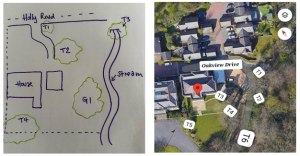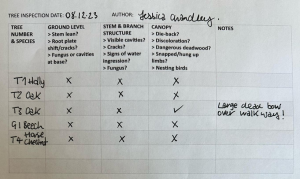Understanding your legal responsibilities as a tree owner is crucial for maintaining safety and compliance. Sabre Tree Surgery is here to guide you through the essentials with our downloadable document:
Whether you’re a homeowner or a property manager, this resource will help you navigate your obligations and ensure the health and safety of your trees.
Information for tree owners regarding tree safety and your liability
Your responsibility as a tree owner is simple. You are expected to take ‘reasonable’ action to prevent ‘foreseeable’ harm.
The best way to do this is to inspect all your trees for visible signs of ill health and structural defects, such as canopy dieback and broken branches. To meet your duty of care you should do this at least once a year and especially after a storm. When I carry out an arborist inspection, I do this via the ‘Ground to crown’ method which is explained in detail below.
Here at Sabre Tree Surgery Ltd, we certainly do not charge to visually inspect trees and quote for any work necessary to meet your duty of care. We can give you a list of the trees you have and identify structural defects such as ‘tight or v type unions’ ‘included bark’, cavities, cracks and diseased trees and advise on a management plan.
If we identify anything we think is a risk, we will provide a price to remove that risk or we will advise that tests on a particular tree are necessary to scientifically measure its structural integrity. At that point we would then recommend a Professional Tree Inspector that has received specialist training to carry out further structural investigation, using various methods such as scans with drills and ultrasound waves.
Professional tree inspections are only necessary if you are applying for planning permission for development or when a visible hazard has been identified and it is deemed reasonable to have the tree’s safety further assessed and often indemnified by a Professional Tree Inspector and their insurance. Otherwise, an initial arborist inspection is advisable for all trees on your property, followed by ongoing inspection by an informed tree owner or designated member of staff.
I hope you have found this information useful. Please don’t hesitate to contact us if you require further advice or would like to arrange a free inspection and quotation for what we refer to as `duty of care tree maintenance`.
Many thanks,
jessica@sabretreesurgery.co.uk
Initial free arborist inspection
To fulfill your obligation as a responsible tree owner it’s important to be sure that there are no foreseeable hazards that could pose a risk to public or property, within your tree stock. As explained above and detailed in the ‘Ground To Crown Tree Inspection Method’ below, anyone can be educated to identify hazards as they arise; such as a dead branch that could later fail or the presence of fruiting bodies of fungus that can indicate a problem with the root/anchoring system. However, a trained arborist has the experience and knowledge to identify what we call ‘structural defects’. These are potential issues within a trees structure that are caused simply by the way the tree has grown.
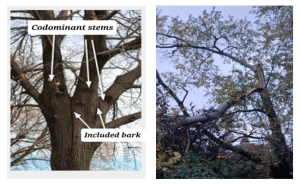
The left picture shows a tree with codominant stems. This particular tree has what we call “included bark” within these tight stem unions. Unions such as these can fail in adverse weather as seen in the right hand photo. A trained arborist will be able to initially identify structural defects such as these and recommend a management plan as part of a free duty of care tree maintenance quotation.
Having an initial arborists tree inspection will allow trees with defects to be identified. These risks are then assessed and control measures can be put in place. The advice regarding a risk management plan will depend on several factors. The most important thing to consider is the trees’ location and targets.
A large cavity was identified in the mid stem of the tree below. Due to its Woodland location, in the bottom of a garden, it had no high value targets such as public or property, therefore it was allowed to stand despite the very large cavity. When it eventually failed in a storm there was no critical damage to people or property. Had this tree been for example in a busy car park, an arborist would have recommended removal to mitigate the risk of critical failure.
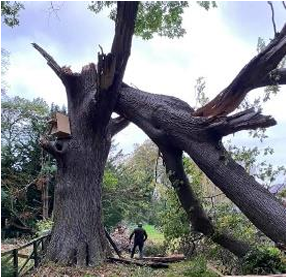
Another factor when deciding on a management plan is the budget. For instance, trees with tight unions like the examples above can be regularly pruned to reduce the weight and wind resistance of the canopy. For example, if the tree was on the grounds of a school with a limited budget, we may recommend the tree is removed to eliminate the cost of future maintenance.
The most cost and time effective way to meet your legal responsibility and to ensure that there are no foreseeable hazards within your tree stock, is to have a free duty of care arborist tree inspection. This will be carried out by a qualified tree surgeon and a quote will be provided for any necessary work needed to meet your duty of care. We can advise on a tree maintenance program that helps to mitigate risk and reduce future maintenance cost, helping land owners and businesses meet their legal responsibility whilst considering a specific budget.
The information below outlines how to visually inspect your trees and record arising hazards or ill health. These checks should be carried out ideally after every storm and at least once a year. A blank tree inspection survey is available to print and can be found https://sabretreesurgery.co.uk/blog/ .
Ground to crown tree inspection method
1. Check the ground for cracks in the earth that indicate movement in the root plate.
2. Check around the base of the tree, especially where the trunk and buttress roots meet with the soil. You are looking for either A) living fruiting bodies of fungus B) a decaying fruiting body, which could present as a soft splodge resembling a cowpat! Fungus on trees can mean nothing or it can mean the root system or structure is compromised depending on what fungus it is, so if you find any you should call an arborist for advice and a free quotation.
*It is always in a trees best interest to keep the base of the tree and if possible, the whole rooting area clear of planting; inspecting this area for root plate movement and fungus is then easier and it also stops trees competing for water and nutrients with other vegetation. Whilst it’s not essential it’s preferable, at least at the immediate base.
3. Check the trunk (referred to by arborists as the ‘stem’) follow this up to the limbs and then the branches. You are looking for signs of:
A) Fungus.
B) Water damage; water can cause rot and in turn structural problems when it sits in old wounds or between branch forks; look for discolouration of the bark or weeping sores.
C) Wind or squirrel damage in the form of snapped and hung-up branches that could become unstable.
D) Cracks in the stem or branches *especially where a branch meets the stem or where there are twin or multiple stems (trunks). Cracks are often an emergency tree work situation, if the section at risk of failure has a high value target such as a public walkway/road or building.
4. Check the crown for die back (indicated by branches with no buds or leaves) or a sparse crown or discolouration of the crown.
*It’s normal to see some dead branches especially underneath the canopy where they may not get enough light; and more so in older trees as they slow or stop growing and begin to slowly recede.
Fungus on a dead branch is normal and part of the decay process. Dead wood can be hazardous if large enough, so it may be necessary to have trees ‘dead wooded’ if they are over high value targets, especially people!!
*The best way to know if your tree looks unhealthy is to know what your healthy tree looks like! So, look at them regularly or at least in winter and summer and especially after adverse weather. Paying extra vigilance to trees that could fall onto property, roads or harm people.
Keep a record of the date you carry out your inspections and if there are any concerns, call an arborist and make a note of what they advised and make sure it’s implemented within the suggested time frame.
*Letting ivy grow in trees in high target areas is not advisable. It makes it impossible to spot disease or damaged branches and encourages grey squirrels to nest; they cause remarkable damage to trees. Worst of all ivy increases the wind sail and weight of the crown making ivy covered trees much more vulnerable to being blown over in the wind.
As a responsible tree owner, it would be useful to know;
1) what type of trees are on your property
2) what the common pests and diseases that are likely to affect that species are; and how to identify them.
There is a wealth of information online and many books and apps that can help you do this. If you don’t have time to gain this knowledge, you should have an arborist inspection carried out and ask for a quote for anything that must be done to meet your duty of care. A qualified tree surgeon shouldn’t charge for this.
How to record tree inspections
Create a plan of the site and clearly mark all trees within the boundary. The plan can be hand drawn and it doesn’t need to be fancy as long as all the trees that you are responsible for are marked and can be identified and referenced in your survey.
Here is an examples of a simple hand drawn plan and I have filled in some of this tree inspection survey to demonstrate how it can be used to keep a record of tree inspections. This entire advice document is available to print as a PDF along with a blank tree inspection survey for your convenience.
